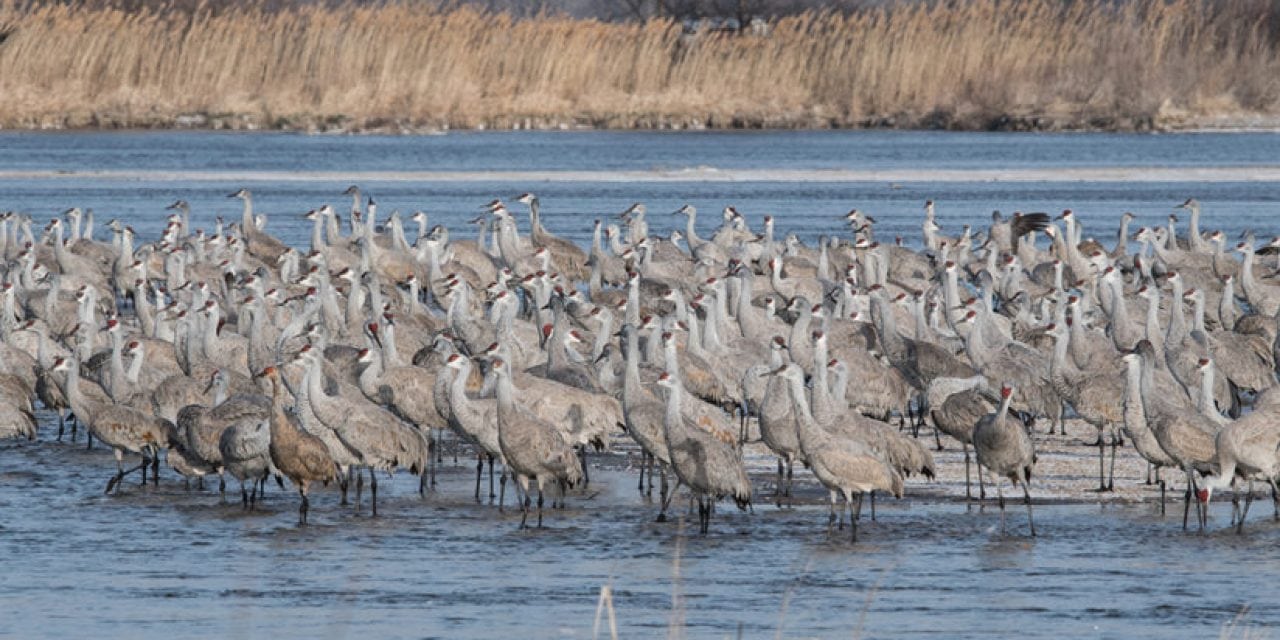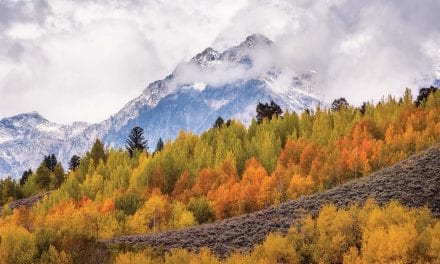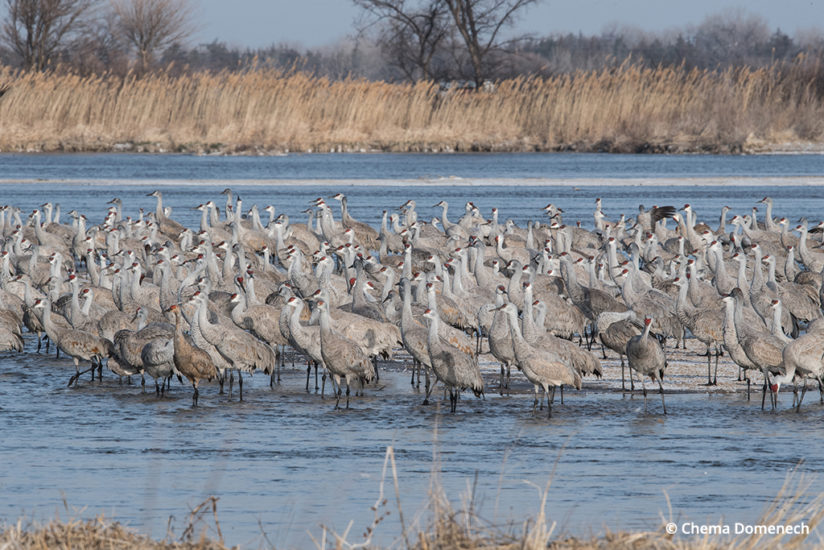
Westward expansion and the fragmentation of the Great Plains saw the migration of the American bison disappear, leaving the sandhill crane migration as the last great animal migration in America. Every year, over half a million sandhill cranes converge on a 75-mile stretch of the Platte River for a layover before heading to their breeding grounds in Canada, Alaska and Siberia.
I first became interested in the sandhill crane migration when I met conservation photographer Michael Forsberg at a nature and wildlife photography workshop in Grand Teton National Park. As a teenager, I had driven across the Great Plains as part of my own migration. States like Kansas and Nebraska were drive-through states with the promise of the Rocky Mountains after hours of corn and wheat fields. That opinion changed for me when Forsberg presented his photography of the Great Plains with awe-inspiring images of the sandhill cranes. I quickly got online and began researching the migration, and Forsberg’s name kept popping up alongside the most captivating crane images. I also noticed he was co-leading a trip with OP’s “Wild By Nature” columnist Melissa Groo during the peak of migration in the middle of March. I could not pass up that opportunity.
The second week of February, I received an email from Forsberg and eagerly read through the contents. The first wave of sandhill cranes had arrived (about 10,000) and were roosting in the Platte River Valley. He expected the number of cranes to be around 300,000 or more by the time we met in mid-March. I had never seen a group of even 10,000 animals, and 300,000 was just unimaginable. For the first time in my life, I was going to Nebraska with the intention of staying. With the Rockies at my back and the Great Plains ahead of me, I set out to meet the cranes in Kearney, Nebraska.
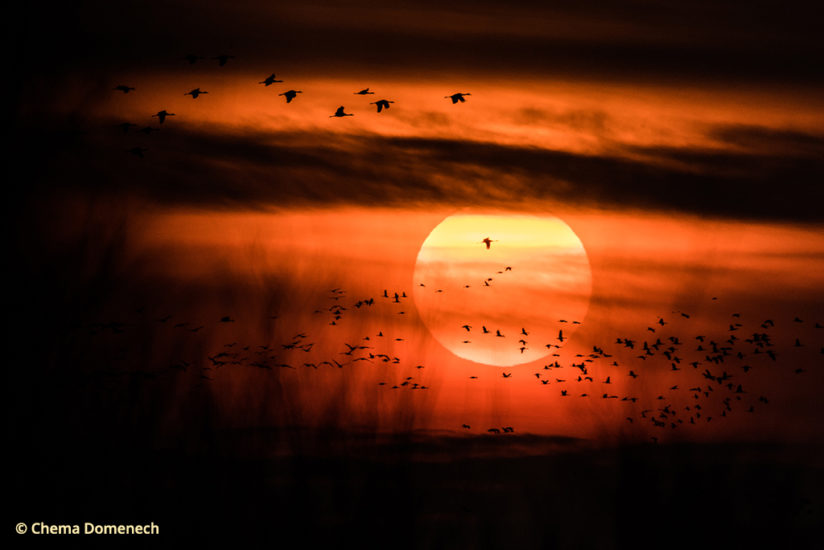
Kearney sits right in the middle of the migration confluence. The cranes travel from their wintering grounds in Texas, New Mexico, Arizona and northern Mexico. They gather in Kearney to build up energy reserves before continuing their journey toward their nesting grounds in the Arctic Circle. At night, the birds roost together in large numbers on the Platte River sandbars. While the number of cranes in the wild remains stable, their roosting habitat has decreased significantly. The spring runoff that used to clear the sandbars of vegetation has been reduced by up to 70 percent. That is where the folks at the Audubon Rowe Sanctuary come in. Every year, they clear the growth on the sandbars and reclaim a portion of sandhill crane habitat.
It is 5 a.m. when my alarm goes off, but I have been awake for an hour, unable to sleep due to my excitement. We meet in the hotel lobby and head toward the Platte River. Our destination is a blind on the river’s north bank. We take an unmarked dirt road and turn our headlights off. On that road is a gate you can only find if you’ve been there before. This is my initiation into a spiritual photography experience that transcends the physical world. In the distance, you can hear the ancient dinosaur-like calling of the cranes. A crane fossil found in Nebraska, estimated to be 10 million years old, is identical in structure to the modern sandhill crane, which would make the crane the oldest-known bird species alive today. Illuminated only by the light of a full moon, we make our way across a field 200 yards wide toward the trumpeting of the cranes and arrive at a small wooden blind.
An hour before sunrise, the blind is pitch dark. The cranes are roosting right in front of us. We are doing our best to remain quiet, but I am terrified that any movement will send the cranes flying away. Sandhill cranes are shot in every state and province along the Central Flyway — except for Nebraska — so by the time they arrive on the Platte River, they have no tolerance for human presence. I quietly set my tripod up with my 600mm lens and point it out one of the small windows of the blind. It is a cold Nebraska morning, 16 degrees, but with the wind blowing at a constant 25 miles per hour, it feels even colder. The blind hides us from the cranes but does little to protect us from the wind.
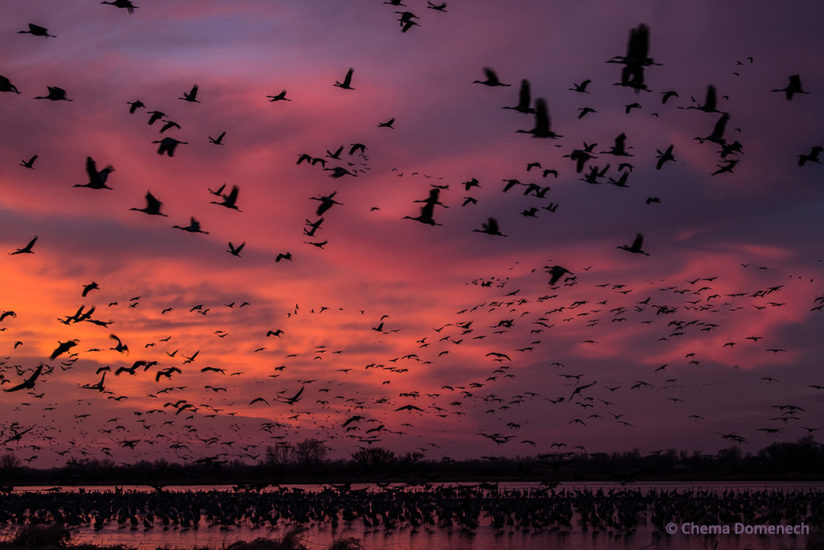
As the first rays of sunlight appear, I want to start photographing, but I am paralyzed. Less than 100 yards in front us on a sandbar still dusted with snow and ice, a group of about a thousand cranes is huddled up. Some are awake, but others remain sleeping with their heads tucked firmly into their back feathers. I look up and down the river, and every sandbar in sight is covered in cranes. I am trying to take it all in. This is all new but strangely familiar. We estimate that there over 50,000 birds in our two-mile stretch of the river.
After few minutes observing, I get back to my camera and begin photographing the cranes. As more and more of them wake, the Platte River rises to a crescendo of thousands of cranes calling. I am focused on a group halfway across the river awaiting the climax, and then it happens. A single crane 100 yards up the river lifts off, and the thunderous sound of wings flapping rolls down the river. In less than 30 seconds, 50,000 cranes clear from the sandbars and take to the sky. They won’t be coming back until dusk. The cold air filling my lungs makes me realize that I had stopped breathing.
Photographing the sandhill cranes presents a series of difficult challenges. There are 50,000 birds, and every moment at least a few of them are doing something exciting. At first I try to follow the action, but I am constantly just missing. I could do this for the next three days and get nothing, so I decide to change strategies. I commit to small groups, and through close observation I start understanding and predicting the cranes’ behavior. Flashes are not an option, and lighting varies widely. Having a plan is good, but you must be flexible. I came in with the expectation of photographing extremely sharp portraits. That first morning is frustrating until I embrace the creative possibilities.
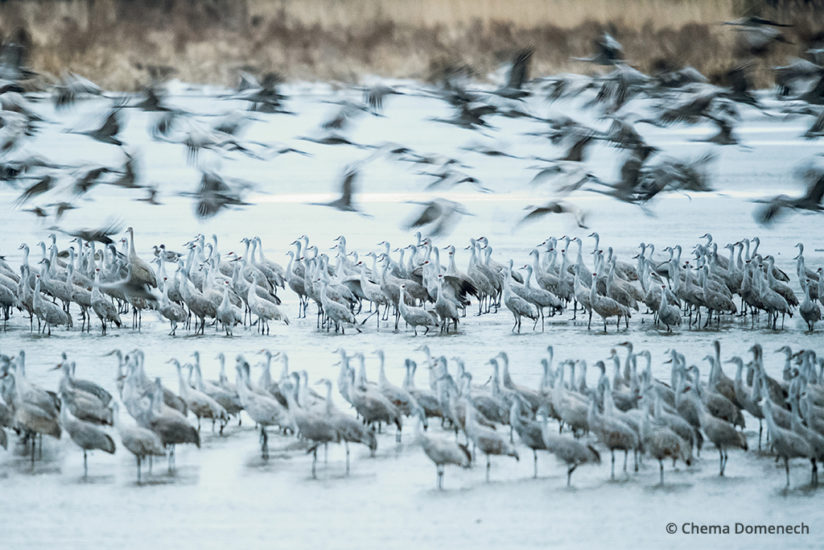
I find that at 1/30 sec. shutter speed with my 600mm lens, the cranes in flight blur, but those on the ground are still enough to remain sharp. Most of the time, I photograph wide open at ƒ/4 for a shallow depth of field. I also want to capture the detail in the plumage of the cranes as they dance in the morning light. That requires completely freezing their motion using a shutter speed of 1/2000 sec. On the other extreme, I experiment with long exposures of 30 seconds when the cranes are roosting in complete darkness, which creates ghosted images of the cranes and burns their reflection into the river.
The photo opportunities extend beyond the river. As the cranes head for the cornfields, we return to the hotel to offload our images and take a rest. I quickly realize that napping is going to be an exercise in futility. Every time I close my eyes, I see the cranes, so I, too, head for the fields, where a dichotomy becomes apparent. While the Platte River is running low due to the diversion of water for agricultural use, waste grain from the previous fall harvest provides the cranes with the nutrients and fat reserves they will need to complete their journey.
Photographing the cranes in the fields requires patience. Your car serves as a blind, and leaving it means you risk scaring the cranes. After driving around the fields for a while, I challenge myself to remain quietly in one spot and hope the cranes become accustomed to my presence. I find a small patch of tall grass and wait. Lying down at the edge of the field, I feel more connected to the cranes, and I can acknowledge their perspective. Hours pass like minutes, and before I know it the sun is dropping and the cranes are headed back to the Platte River.

In the evening, we use a different blind at Rowe Sanctuary on the south bank of the Platte, a newly constructed blind that stands level with the river about 20 yards from a sandbar. Whether the cranes decide to roost on that spot is a matter of luck and patience. A family of two or three cranes chooses the sandbar, and soon hundreds of cranes follow. Photograph too soon and you risk spooking the cranes and they don’t return. You must wait until a certain number of cranes gather and they feel safe.
We are particularly fortunate that night — the cranes gather on the sandbar, and the sky lights up with what is probably the most spectacular sunset I have ever seen. What begins as a fiery display of reds and oranges transitions into a velvety show of pinks and purples in a moment that seems to last an eternity. Safely on the sandbar, the cranes settle in for the night to start the process all over again tomorrow.
While the sandhill cranes have adapted to human activity, their behavior is still ruled by the natural rhythms of the earth. We don’t yet know what effects the droughts and stronger storms due to climate changes will have on the cranes, but observing and creatively photographing them necessitates that we connect to the same rhythms.
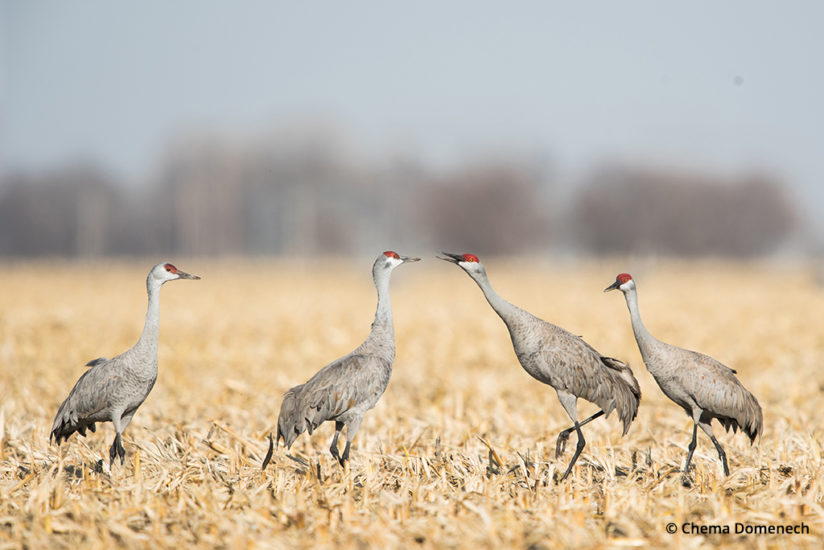
Tips For Photographing The Sandhill Crane Migration
- Book a Blind at Audubon Rowe Sanctuary. This is your best chance to get close to the cranes. You are also contributing to the ongoing efforts to restore sandhill crane habitat each year. You can book a blind starting Jan. 2.
- Bring a Long Telephoto and a Wide Lens. Something in the range of 400-800mm is needed to fill your frame when the cranes are at long distances, but don’t forget your wide lens to photograph the spectacular prairie sunsets.
- Vary Your Exposures. Try both long and fast exposures. Embrace the layers of the landscape and the effects of blurring and freezing motion. A sturdy tripod is a must for the long exposures.
- Explore the Fields. The cranes spend most of their day eating in the fields. This is a great opportunity to get close.
- Dress in Layers. One day on the Platte River can be 70 degrees and sunny, and the next it’s 10 degrees and a blizzard. Either way it is magical — dressing in layers will help you stay comfortable.
See more of Chema Domenech’s work at chemadomenech.com.
YOU MIGHT ALSO LIKE

Wildlife Of The Great Plains
A lingering wildness worth protecting still survives on America’s prairies. Read now.
The post Sandhill Crane Migration appeared first on Outdoor Photographer.

